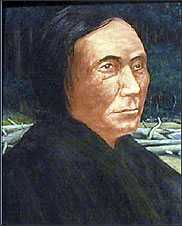Leschi (Native American leader)
| Leschi | |
|---|---|
 | |
| Chief Leschi | |
| Nisqually leader | |
| Personal details | |
| Born | 1808 Eatonville, Washington |
| Died | February 19, 1858 Lake Steilacoom |
| Resting place | Puyallup Tribal Cemetery – Tacoma, Washington 47°14′19″N 122°23′56″W / 47.2386°N 122.3989°W |
Chief Leschi (/ˈlɛʃaɪ/; 1808 – February 19, 1858) was chief of the Nisqually Native American tribe. He was hanged for murder in 1858, but exonerated in 2004.
Life
Leschi was born in 1808 near what is today Eatonville, Washington, to a Nisqually father and a Yakama mother. He was appointed chief by Isaac Stevens, first governor of Washington Territory, to represent the Nisqually and Puyallup tribes at the Medicine Creek Treaty council of December 26, 1854, which ceded to the United States all or part of present-day King, Pierce, Lewis, Grays Harbor, Mason, and Thurston Counties and stipulated that the American Indians inhabiting the area move to reservations. Some maintain that Leschi either refused to sign (and had his "X" forged by another) or signed under protest. The historical record is unclear on this point. However, he did argue that the reservation designated for the Nisqually tribe was a rocky piece of high ground unsuited to growing food and cut off from access to the river that provided the mainstay of their livelihood, salmon.[1]
In 1855, Leschi traveled to the territorial capital at Olympia to protest the terms of the treaty. In October, Acting Governor Charles H. Mason ordered that Leschi and his brother Quiemuth be taken into "protective custody" and sent the militia after them, thereby initiating the Puget Sound War of 1855–1856. Leschi became war chief, in command of around 300 men, and led a small number of raids which panicked the white population. Early in the conflict, Territorial militiamen Abram Benton Moses and Joseph Miles (or Miller) were killed. Infuriated territorial authorities blamed the killings on Leschi, who remained at large for nearly a year. Convinced that white settlers were cooperating with Leschi, Stevens declared martial law over Pierce County on April 2, 1856. (Stevens was later charged with contempt of court in relation to this declaration, however as governor he pardoned himself.[2])
Leschi was taken into custody in November 1856, and his brother Quiemuth turned himself in shortly thereafter. Quiemuth was murdered on November 18, 1856, by an unknown assailant, in Governor Stevens's office in Olympia, where he was being held for the night on his way to the jail at Fort Steilacoom, now in Lakewood, Washington. Leschi himself was put on trial in 1858 for the murder of Colonel Moses, which he denied having committed. His first trial resulted in a hung jury because of the judge's instruction that killing of combatants during wartime did not constitute murder. He was convicted and sentenced to death in a second trial in which this instruction was not given and his lawyers, Frank Clark and William Wallace, were not allowed to introduce potentially exonerating evidence.
One supporter, William Fraser Tolmie, petitioned the new governor, LaFayette McMullen, to pardon Leschi, but the governor refused. Another supporter, United States Army officer August Kautz, published two issues of a newspaper defending Leschi. Titled the Truth Teller, the newspaper's masthead stated: "Devoted to the Dissemination of Truth and the Suppression of Humbug." Tolmie's petition and the front page of the Truth Teller are reprinted in Ezra Meeker's 1905 history, The Tragedy of Leschi.[3] Meeker was one of two who voted for acquittal on the first hung jury trial.
Execution
Leschi's execution was initially scheduled for January 22, 1858, but his supporters arranged an elaborate plot in which the Pierce County sheriff, George Williams, allowed himself to be arrested by sympathetic members of the United States Army rather than carry out the execution. On February 19, 1858, Leschi was hanged in a small valley, from a hastily constructed gallows near Lake Steilacoom, on land which later became a golf course and is now housing. There is a small monument nearby in a strip mall in Lakewood. The hangman is reported to have later said "I felt then I was hanging an innocent man, and I believe it yet."
Legacy
Roughly three decades later, Frederick J. Grant named the Leschi neighborhood in Seattle after the chief in the late 1880s. Today, the neighborhood and its waterfront park; schools in Seattle and Puyallup; and streets in Seattle, Lakewood, Steilacoom, Anderson Island, and Olympia, bear his name. Additionally, the MOUT site at Joint Base Lewis-McChord is named Leschi Town in his honor.
In March 2004, both houses of the Washington state legislature passed resolutions stating that Leschi was wrongly convicted and executed and asked the state supreme court to vacate Leschi's conviction. The court's chief justice, however, said that this was unlikely to happen, since it was not at all clear that the state court had jurisdiction in a matter decided 146 years earlier in a territorial court. On December 10, 2004, Chief Leschi was exonerated by a unanimous vote by a Historical Court of Inquiry following a definitive trial in absentia.[4]
Category
References
- ↑ Carpenter, Cecelia Svinth (1977). They Walked Before: The Indians of Washington State. Tacoma, Washington: Washington State American Revolution Bicentennial Commission. p. 29. ISBN 0-917048-04-0.
- ↑ "Governor Stevens’ Famous Pardon of Himself". Washington Historical Quarterly 25 (3). 1934.
- ↑ Meeker, Ezra (1905). Pioneer Reminiscences of Puget Sound: The Tragedy of Leschi. Seattle.
- ↑ "Court acquits Indian chief hanged in 1858". Associated Press. 2004-12-14.
External links
- Leschi: Justice In Our Time, provided by the Washington State Historical Society
- Leschi at Find a Grave